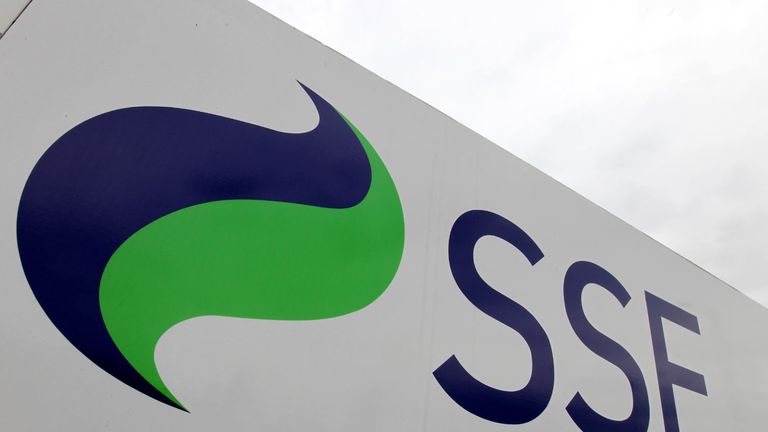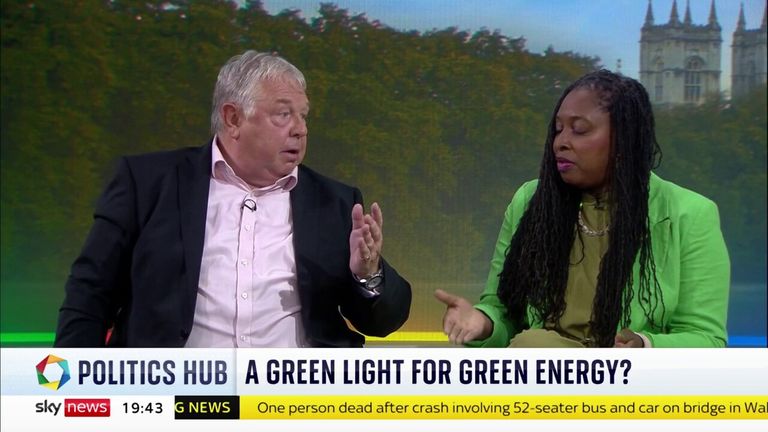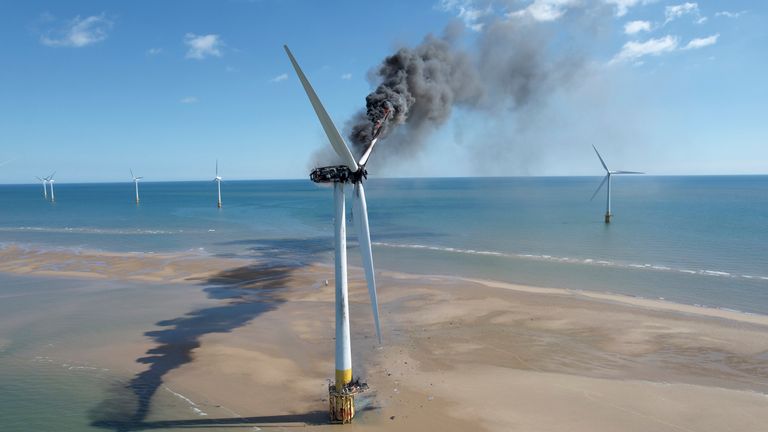Energy industry leaders have warned the UK could fall behind a key target for new offshore wind power ahead of the results of a government auction that is widely expected to flop.
Multiple industry sources have told Sky News the auction, the results of which are expected to be announced on Friday, has received little or no interest.
Insiders say the process has struggled to attract bidders because the government has set the maximum price generators can receive as too low, failing to reflect the rising costs of manufacturing and installing turbines.
The industry has been hit by inflation that has seen the price of steel rise by 40%, supply chain pressures and increases in the cost of financing.
Several companies, including the UK’s largest renewables generator SSE, have ruled themselves out of the auction, with one source saying the number of potential bidders was “between two and zero, with expectations at the lower end of that range”.
The renewables auction is an annual process in which the government attempts to incentivise private sector investment in a range of power sources through a mechanism known as “contracts for difference” (CfDs).
The auction works in reverse, with the government setting a maximum reference price, effectively a cap on what consumers can be charged, and in normal circumstances generators bid below that to provide power over a 15-year contract.
Under the CfD, generators are guaranteed a price for the power they produce, with the government making up the difference if wholesale prices fall below that price.
Read more:
Boost for onshore wind with government to relax planning rules
Onshore wind farm rules to change
When wholesale prices are higher, as they have largely been since the Ukraine war began, generators pay the difference above the guaranteed price back to the Treasury.
‘The sums didn’t add up’
In theory this delivers value to consumers and suppliers but the chief executive of SSE, Alistair Phillips-Davies, told Sky News the price cap in this auction of £44MW/h, only a little above last year’s price, meant it was not viable.
“For the project we had, which is a little smaller than some and in deeper waters further north in the UK, we just wouldn’t have been able to even get a bid in at that cap price,” he said.
“The sums didn’t add up, we wouldn’t have been able to make an economic bid at that level. We’d have been struggling with write-offs, and we’ve seen some competitors in the sector have unfortunately suffered in recent weeks.”
Mr Phillips-Davies said the government needed to act now to ease market conditions for the renewables sector to ensure next year’s auction generated capacity.
He suggested additional taxes on renewables profits be withdrawn in 2024 rather than 2028, bringing the UK in line with Europe, extending capital allowances to compete with the US subsidy regime the Inflation Reduction Act (IRA), as well as ensuring a more realistic price cap in the next auction round.
He pointed to a recent auction in Ireland, operating under a different structure, that set a price of €150 MW/h.
He said: “I think people will need to look at the cap, while being sensitive to what consumers should be paying, and what we’ve got to do is be ambitious next year.
“We’ve got to be thoughtful about what we do and make sure that the next auction is constructed not only to get people to win an auction, but to actually build a piece of kit.”
This auction round, technically known as Allocation Round 5 (AR5) is expected to attract bids for solar and onshore wind capacity, but failure to secure significant new offshore wind capacity would be a blow to the government’s target of reaching 50GW by 2030.
‘Fingers in their ears’
It will also intensify the increasingly sharp debate over the true cost of achieving net zero to consumers and the public purse, as the energy transition moves from abstract policy theory to practical delivery.
Insiders say officials were repeatedly warned by industry that the auction would fail unless the price was increased.
Shadow energy secretary Ed Miliband said this week ministers “had put their fingers in their ears.”
The UK currently has 14GW of functioning offshore wind capacity, placing huge pressure on the next two annual auctions to fill the gap.
Offshore wind is the backbone of the UK’s renewable energy supply, providing 40% of electricity last year, and the target is a crucial plank in the wider goal of reaching net-zero by 2050.
Previous auctions have been successful in increasing offshore wind capacity, with last year’s round attracting 7GW of capacity from five operators.
One of those projects, run by Swedish state-owned power company Vattenfall, has already been mothballed however because of rising costs hitting the industry.
‘Very difficult market’ for offshore wind developers
Lisa Christie, UK country manager for Vattenfall, told Sky News the investment model no longer matched economic reality.
“The economics at the moment simply don’t stack up,” she said.
“There’s a number of reasons for that. It’s the war in Ukraine, we’ve seen rises in inflation, we’ve seen rises in the cost of capital, obviously rises in commodity costs.
“You put all of that together. And it’s just a very, very difficult market environment for offshore wind developers right now.
“I think we’re at a very difficult point. And we have a lot of offshore wind farms, including Vattenfall, that haven’t been able to take fields where perhaps you wouldn’t have expected them to do.
“So there is a challenge in the industry, I don’t think is insurmountable and there is still time for the government to turn this around.
“So what we’re really looking for is to put the CfDs back onto a financially sustainable footing and then we can reap the benefits that increased offshore wind deployment bring.”
Concerns UK will lose offshore wind superiority
Major suppliers to the industry are also concerned that any political drift in the build up to the election could see the UK lose its pre-eminence in offshore wind.
Laura Fleming, the UK managing director of Hitachi, which produces high-voltage direct cables that bring power onshore, said the UK needs to compete with more generous subsidy regimes around the world.
“The investment climate in the UK needs to send a clear signal that we are open for business, and compared to the IRA in the US, and the new green deal in Europe, we need to ensure that we still stand out.”
The renewables industry insists that even at a higher price in this auction, wind power would still be substantially cheaper than fossil fuel alternatives. At their peak last year wholesale gas prices were up to nine-times higher than offshore wind strike prices.
Renewables generated under CfDs can also return money to the taxpayer. Since the invasion of Ukraine forced up electricity prices many wind farms operating under CfDs have been paying back millions of pounds to the Treasury.
Mr Phillips-Davies said: “We’ve got to remember at the moment offshore wind is looking a bargain compared to wholesale energy prices. It’s half the price or less of where the current market is, so we need to be building more.”



